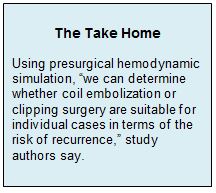Key Points:
- Study examines influences on recanalization following coil embolization of basilar tip aneurysms
- Coil packing density, aneurysmal inflow rate coefficient emerge as independent risk factors
After coiling of basilar tip aneurysms, both low coil packing density and aneurysmal inflow rate coefficient, which is influenced by basilar bifurcation configuration, independently predict recanalization. The findings were published online September 13, 2016, ahead of print in Stroke.
Shin-ichiro Sugiyama, MD, of Tohoku University Graduate School of Medicine (Sendai, Japan), identified 82 patients who were treated with endovascular coiling for basilar tip aneurysms and had been followed up for more than 1 year. They assessed presurgical hemodynamics based on computational fluid dynamics with 3-dimensional data derived from rotational angiography.
During postprocessing of the angiographic data, they quantified the rate of net flow entering the aneurysm through its neck and calculated the proportion of the aneurysmal inflow rate to the basilar artery flow rate. They also calculated the correlation between the basilar bifurcation configuration and the hemodynamics.
Among the initial 82 patients, 25 had to be excluded due to difficult vascular geometry reconstruction. In the remaining 57 patients, angiographic recanalization was identified in 19 (33.3%).
Univariate analysis revealed that aneurysmal neck size, height, and aspect ratio as well as aneurysmal inflow rate coefficient and a packing density < 30% were significantly associated with recanalization of coiled aneurysms. Upon multivariate analysis, however, only the proportion of aneurysmal inflow rate to the basilar artery flow rate and coil packing density were identified as independent predictors of recanalization (P = .0143 and .0275, respectively).
Accitionally, investigators found that a “small branch angle formed by the basilar artery and the posterior cerebral artery resulted in the concentration of blood flow into the aneurysm, which was associated with a high aneurysmal inflow rate coefficient and high recanalization rate.” In contrast, a large branch angle diverted the blood flow, which resulted in a lower inflow rate coefficient and a reduced risk of recanalization.
May Not Apply to ‘Giant’ Aneurysms
The authors emphasize that they used a novel methodology to evaluate hemodynamic properties. “The geometries before coil embolization—not after—were used to evaluate the presurgical hemodynamics,” they write. “We suggest that presurgical hemodynamic simulation can provide useful information for predicting the outcome after coil embolization; that is, we can determine whether coil embolization or clipping surgery are suitable for individual cases in terms of the risk of recurrence.” They point out, however, that this pattern may only occur in small aneurysms, since “giant” aneurysms presenting with size-related insufficient angiography were excluded from this study.
Sugiyama et al also recommended using a tight packing density when coiling basilar tip aneurysms with a high aneurysmal flow rate coefficient, in order to minimize the risk of recanalization.
Source:
Sugiyama S, Niizuma K, Sato K, et al. Blood flow into basilar tip aneurysms: A predictor for recanalization after coil embolization. Stroke. 2016;Epub ahead of print.
Disclosures:
Dr. Sugiyama reports no relevant conflicts of interest.
